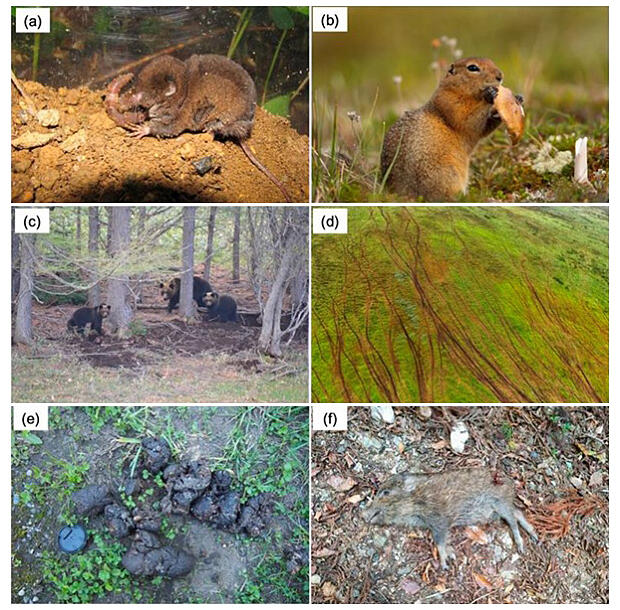On February 7, a joint research group including Assistant Professor Kanji Tomita of Kochi University's Faculty of Agriculture and Marine Science, and the USDA Forest Service, Hokkaido University, Forestry and Forest Products Research Institute of the Forest Research and Management Organization, Okayama University, the University of Tokyo, and Fukui Prefectural University announced their research findings on vertebrates showing that they may alter the spatial structure and distribution of belowground biotic communities, affecting ecosystem functions.

Photo credit: (A) Tomoyuki Namba, (B,D) US Fish and Wildlife Service, (C,E,F) Kanji M. Tomita.
Provided by Kochi University
The components of terrestrial ecosystems can be divided into two categories: aboveground and belowground (soil). Traditionally, interactions between aboveground and belowground organisms have been considered separately. However, it has become increasingly clear that associations between these two components play an important role in ecosystem functions. This association is explained in terms of interactions between plants and soil organisms. Meanwhile, many vertebrates can affect the belowground communities because they forage for animals and dig the soil; however, details, including spatial effects, have remained unknown.
In this study, the research group reviewed the existing literature and identified five mechanisms by which vertebrates affect the belowground communities. Based on the five mechanisms, the effects of vertebrates on the spatial structure and distribution of soil communities were examined and proposed:
- (1) Top-down effects driven by consumption of soil organisms (the impact of consumption by higher-order predators in the food web on communities of lower-level consumers): Ground-dwelling mammals such as shrews and badgers and birds that forage on the ground surface, actively prey on large soil animals such as earthworms. Predation by highly mobile vertebrates may contribute to the stability of local soil food webs and the energy exchange between spatially separated food webs.
- (2) Spore dispersal by consuming fungi: Spore dispersal may alter the spatial structure of soil fungal communities and affect ecosystem functions such as mycorrhizal symbiosis and wood decay. For example, squirrels and mice contribute to spore dispersal by consuming fungal fruiting bodies.
- (3) Increasing the availability of organism-derived detritus through the supply of carcasses and excreta: The availability of organism-derived detritus (organic matter from dead plant tissue, animal carcasses, urine, and feces) increases when carcasses and excreta are introduced into the soil. Because of their uneven spatial distribution, this enhances the spatial heterogeneity of detritus availability, influencing the spatial structure of soil communities.
- (4) Phoresy, in which soil organisms such as oribatid mites and springtails attach themselves to the body surface of vertebrates for traveling: Phoresy allows soil organisms to expand their distribution into new habitats.
- (5) Physical disturbance by digging and trampling: Vertebrate-induced physical disturbances, such as digging and trampling, can influence the spatial structure of soil communities due to their uneven distribution, similar to detritus. For example, many mammals, such as prairie dogs and brown bears, dig the ground for nesting and foraging, and ungulates trample the ground as they move.
The effects of vertebrates discussed in this article could ultimately alter soil organism-driven ecosystem functions, such as soil carbon storage.
The research group believes that these pathways should be considered when predicting changes in ecosystem functions as a consequence of conservation and population management of large vertebrates.
Tomita said, "I am studying a unique phenomenon of brown bears feeding on cicada larvae. During the course of research on this phenomenon, I came up with the idea to write up on the relationship between soil organisms and large mammals in general. A large part of the interactions between soil organisms and large animals remains unknown. I hope this review article can catalyze further progress of research on the complex associations between aboveground and belowground organisms."
Journal Information
Publication: Trends in Ecology and Evolution
Title: The underappreciated roles of aboveground vertebrates on belowground communities
DOI: 10.1016/j.tree.2024.12.011
This article has been translated by JST with permission from The Science News Ltd. (https://sci-news.co.jp/). Unauthorized reproduction of the article and photographs is prohibited.




